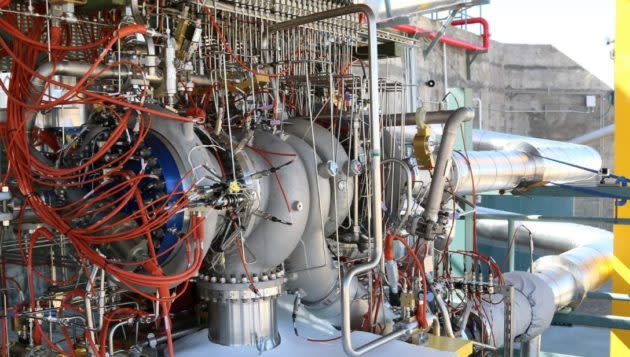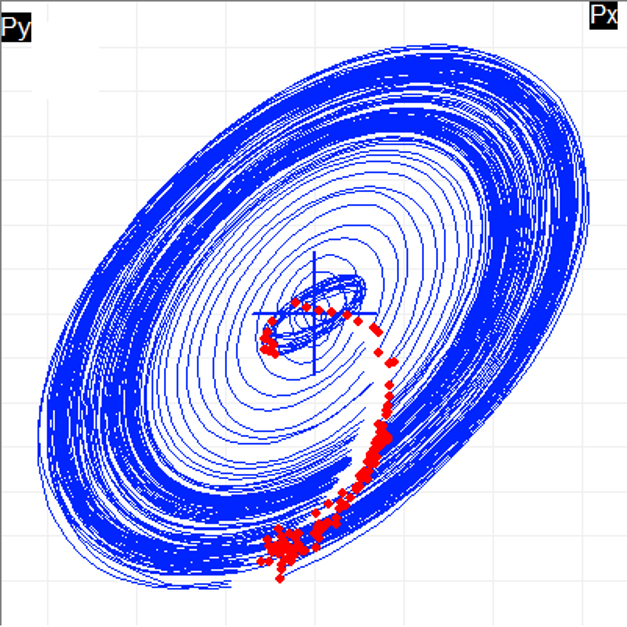Jeff Bezos does a deep dive into bearings in Blue Origin’s BE-4 rocket engine update

What’s the difference between ball bearings and hydrostatic bearings? You should have more of an inkling after checking out Amazon billionaire Jeff Bezos’ latest update on the development of Blue Origin’s BE-4 rocket engine.
The engine is undergoing testing for use not only on the New Glenn rocket that Bezos’ space venture is planning, but also on United Launch Alliance’s next-generation Vulcan rocket.
The BE-4 is designed to provide 550,000 pounds of thrust, propelled by liquid oxygen and liquefied natural gas. Bezos says that kind of thrust should be enough to send a payload on the first leg of a trip to the moon when seven of them are firing together.
But that kind of performance can involve a lot of wear and tear, particularly if you’re using traditional ball and roller bearings. To maximize the engine’s reusability, Blue Origin’s team is taking a different approach. To keep the BE-4 running smoothly, Bezos says the turbine at the heart of the engine’s turbopump will use a thin film of the fluid propellants as its bearings.
Reusability is a key selling point for the BE-4, and ULA will be watching the engine’s performance closely as Blue Origin puts it through full-scale tests over the next several weeks.
If the BE-4 stumbles, ULA might have to turn to a Plan B, and Blue Origin’s plans for the New Glenn satellite launch business would suffer a heavy blow. But if everything works, that’ll be a big boost for Bezos’ space company, which is also working on a suborbital spaceship powered by the smaller, hydrogen-fueled BE-3 engine.
Here’s the full text of today’s email update from Bezos:
“Although the BE-4 turbopump is smaller than your refrigerator, it generates 70,000 horsepower from a turbine running at nearly 19,000 revolutions per minute that pumps cryogenic propellants to pressures just under 5,000 pounds per square inch. To react the forces generated by the rotating turbine and impellers inside the pump, production rocket turbopumps to date have used traditional ball and roller bearings. For BE-4, we’re doing something different – we’re using hydrostatic bearings.
“A hydrostatic bearing relies on a fluid film supplied by a high-pressure source to provide support for the shaft and cause it to float without contacting the static structure except at startup and shutdown. The BE-4 main turbopump uses hydrostatic journal bearings for radial support and hydrostatic axial bearings to carry axial thrust. The system is bootstrapped. The high pressure fluid films for the bearings are supplied by the propellants themselves – liquefied natural gas and liquid oxygen – tapped off from the pump discharge flows.
“Material selection is a critical consideration for this approach, as there is physical contact between the bearing surfaces during the start transient before the fluid film is fully established and during the shutdown transient as the fluid film dissipates. With lab-scale tests and full-scale bearing rig tests using actual pump hardware, we evaluated over 20 material combinations in over a hundred tests, leading to our baseline material and coating choices.
“Extensive rotordynamic and computational fluid dynamics analyses have shown the feasibility of this design, and recent powerpack tests confirmed that this approach works during the startup and shutdown transients – the most critical phases. The shaft orbit plot below shows that the turbopump lifts off smoothly and centers during a typical start transient, demonstrating a smooth ride on a film of propellant.
“Why do we go to all this trouble instead of just using traditional bearings? Engine life. We’re relentlessly focused on reusability, and properly designed hydrostatic bearings offer the potential for longer engine life without refurbishment. This is one of the many engineering decisions we’ve made that we hope will lead to reusability – not just in principle – but to practical, operational reusability. If ‘reusability’ requires significant refurbishment, inspection, and re-validation between flights, then it simply won’t lead to the far lower launch costs we need to achieve our vision of millions of people living and working in space.
“We’ll keep you up to date as our testing progresses in the coming weeks.
“Gradatim Ferociter!”

To get Bezos’ updates delivered to your e-mailbox, register on the Blue Origin website.
More from GeekWire:
Jeff Bezos says Blue Origin’s next spaceflight will test parachute failure
Jeff Bezos gives a geeky boost to Blue Origin’s BE-4 rocket engine boost pump
Jeff Bezos provides a sneak peek at Blue Origin’s orbital rocket factory in Florida
Jeff Bezos unveils the design for Blue Origin’s ‘New Glenn’ orbital rocket
